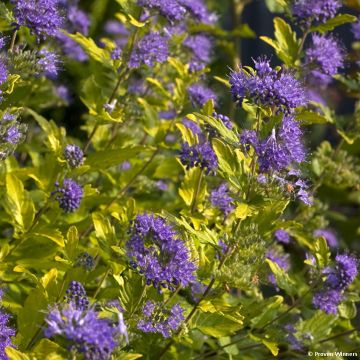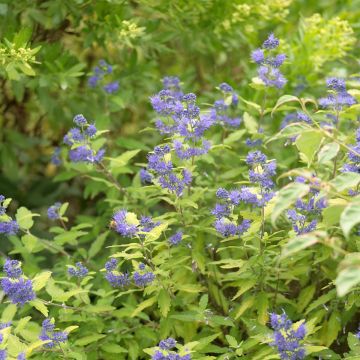

Caryopteris clandonensis Blue Balloon - Bluebeard


Caryopteris clandonensis Blue Balloon - Bluebeard
Caryopteris clandonensis Blue Balloon - Bluebeard
Caryopteris clandonensis Blue Balloon®
Bluebeard, Blue Spirea, Blue Mist Shrub
Why not try an alternative variety in stock?
View all →This plant carries a 24 months recovery warranty
More information
We guarantee the quality of our plants for a full growing cycle, and will replace at our expense any plant that fails to recover under normal climatic and planting conditions.
From €5.90 for pickup delivery and €6.90 for home delivery
Express home delivery from €8.90.
Does this plant fit my garden?
Set up your Plantfit profile →
Description
Caryopteris x clandonensis 'Blue Balloon' is a cultivar of spirea whose name describes its very compact ball shape, completely covered with large rounded clusters of deep blue, very nectar-rich flowers! This variety forms an exceptionally floriferous bush with even the shortest lateral branches flowering making it resemble a big blue balloon at the end of summer. Its moderate growth allows it to be used to create beautiful borders or to enhance a terrace container, close enough to appreciate the spicy fragrance of its foliage which is dark green with silver undersides. It is a vigorous and hardy bush that is particularly suited to full sun and well-drained soils, preferably fertile, even chalky and dry.
Caryopteris x clandonensis 'Blue Balloon' is one of the hybrids obtained by cross-breeding Caryopteris incana, an Asian bush known as 'Bluebeard', and Caryopteris mongolica, hardier and native to the colder regions of Mongolia and northern China. They all belong to the Verbenaceae family.
The 'Blue Balloon' variety is distinguished by a perfect ball-shaped habit, with all stems, even the shortest and lowest, producing round clusters of deep blue flowers! The plant forms a small, bushy and compact shrub, 80 cm (31.5 in) tall and 60 cm (23.6 in) wide. It blooms from the second half of summer until the beginning of autumn. Its inflorescences appear on the upper half of the current year's branches consisiting of countless small lavender-blue buds gathered in large whorls or dense bouquets arranged in a staggered manner. The buds open into small flowers with prominent stamens which are particularly nectar-rich and attract many colourful butterflies. The deciduous foliage is a collection of thin, triangular leaves, 3 to 5 cm (1.2 to 2 in) long and aromatic, with irregularly toothed edges, arranged opposite each other on straight stems. They have a deep green colour with silver undersides and when crushed, they release a resinous scent.
Caryopteris x clandonensis 'Blue Balloon' is good for borders, mass plantings, and low hedges, alongside other shrubs with equally undemanding summer flowering: Russian sage (Perovskia), shrubby potentillas, St. John's wort, catmints, Ceratostigma griffithii, lavenders, dwarf buddleias, perennial or shrubby salvias... In a dry garden with a more natural style, plant it with grasses and silver-leaved shrubs like stipas and artemisias. A very romantic scene can be created in late summer by combining pink caryopteris with shrubby lavateras (Barnsley, Princesse de Ligne, Blue Bird), shrubby artemisias, and asters. A group of 3 shrubs surrounding a pastel reblooming rose is a splendour in September, as their very different styles of flowering are perfectly complementary. It can also be planted in a deep and beautiful pot on the terrace or balcony, in a sheltered position.
Report an error about the product description
Caryopteris clandonensis Blue Balloon - Bluebeard in pictures




Plant habit
Flowering
Foliage
Botanical data
Caryopteris
clandonensis
Blue Balloon®
Verbenaceae
Bluebeard, Blue Spirea, Blue Mist Shrub
Cultivar or hybrid
Other Caryopteris
Planting and care
Caryopteris are sun-loving plants that require well-drained soil. They should be planted early in autumn, or in spring in colder regions, in a very sunny location and in a light, well-drained soil, even if it is rocky or sandy, but still deep. While Caryopteris is not sensitive to limestone, it will be more beautiful in humus-rich soil. Waterlogged soil in winter will strongly affect its hardiness. In well-drained soil and sheltered conditions, this plant can tolerate temperatures as low as -15 to -20°C (5 to -4 °F) for short periods, for example, late at night. In colder regions, it is advisable to plant it against a south-facing wall. It is also worth noting that plants grown in pots are more susceptible to frost than those planted in the ground. Prune in late winter or very early spring to maintain a compact habit and promote the appearance of flowers on the new shoots of the year.
Planting period
Intended location
Care
-
, onOrder confirmed
Reply from on Promesse de fleurs
Haven't found what you were looking for?
Hardiness is the lowest winter temperature a plant can endure without suffering serious damage or even dying. However, hardiness is affected by location (a sheltered area, such as a patio), protection (winter cover) and soil type (hardiness is improved by well-drained soil).

Photo Sharing Terms & Conditions
In order to encourage gardeners to interact and share their experiences, Promesse de fleurs offers various media enabling content to be uploaded onto its Site - in particular via the ‘Photo sharing’ module.
The User agrees to refrain from:
- Posting any content that is illegal, prejudicial, insulting, racist, inciteful to hatred, revisionist, contrary to public decency, that infringes on privacy or on the privacy rights of third parties, in particular the publicity rights of persons and goods, intellectual property rights, or the right to privacy.
- Submitting content on behalf of a third party;
- Impersonate the identity of a third party and/or publish any personal information about a third party;
In general, the User undertakes to refrain from any unethical behaviour.
All Content (in particular text, comments, files, images, photos, videos, creative works, etc.), which may be subject to property or intellectual property rights, image or other private rights, shall remain the property of the User, subject to the limited rights granted by the terms of the licence granted by Promesse de fleurs as stated below. Users are at liberty to publish or not to publish such Content on the Site, notably via the ‘Photo Sharing’ facility, and accept that this Content shall be made public and freely accessible, notably on the Internet.
Users further acknowledge, undertake to have ,and guarantee that they hold all necessary rights and permissions to publish such material on the Site, in particular with regard to the legislation in force pertaining to any privacy, property, intellectual property, image, or contractual rights, or rights of any other nature. By publishing such Content on the Site, Users acknowledge accepting full liability as publishers of the Content within the meaning of the law, and grant Promesse de fleurs, free of charge, an inclusive, worldwide licence for the said Content for the entire duration of its publication, including all reproduction, representation, up/downloading, displaying, performing, transmission, and storage rights.
Users also grant permission for their name to be linked to the Content and accept that this link may not always be made available.
By engaging in posting material, Users consent to their Content becoming automatically accessible on the Internet, in particular on other sites and/or blogs and/or web pages of the Promesse de fleurs site, including in particular social pages and the Promesse de fleurs catalogue.
Users may secure the removal of entrusted content free of charge by issuing a simple request via our contact form.
The flowering period indicated on our website applies to countries and regions located in USDA zone 8 (France, the United Kingdom, Ireland, the Netherlands, etc.)
It will vary according to where you live:
- In zones 9 to 10 (Italy, Spain, Greece, etc.), flowering will occur about 2 to 4 weeks earlier.
- In zones 6 to 7 (Germany, Poland, Slovenia, and lower mountainous regions), flowering will be delayed by 2 to 3 weeks.
- In zone 5 (Central Europe, Scandinavia), blooming will be delayed by 3 to 5 weeks.
In temperate climates, pruning of spring-flowering shrubs (forsythia, spireas, etc.) should be done just after flowering.
Pruning of summer-flowering shrubs (Indian Lilac, Perovskia, etc.) can be done in winter or spring.
In cold regions as well as with frost-sensitive plants, avoid pruning too early when severe frosts may still occur.
The planting period indicated on our website applies to countries and regions located in USDA zone 8 (France, United Kingdom, Ireland, Netherlands).
It will vary according to where you live:
- In Mediterranean zones (Marseille, Madrid, Milan, etc.), autumn and winter are the best planting periods.
- In continental zones (Strasbourg, Munich, Vienna, etc.), delay planting by 2 to 3 weeks in spring and bring it forward by 2 to 4 weeks in autumn.
- In mountainous regions (the Alps, Pyrenees, Carpathians, etc.), it is best to plant in late spring (May-June) or late summer (August-September).
The harvesting period indicated on our website applies to countries and regions in USDA zone 8 (France, England, Ireland, the Netherlands).
In colder areas (Scandinavia, Poland, Austria...) fruit and vegetable harvests are likely to be delayed by 3-4 weeks.
In warmer areas (Italy, Spain, Greece, etc.), harvesting will probably take place earlier, depending on weather conditions.
The sowing periods indicated on our website apply to countries and regions within USDA Zone 8 (France, UK, Ireland, Netherlands).
In colder areas (Scandinavia, Poland, Austria...), delay any outdoor sowing by 3-4 weeks, or sow under glass.
In warmer climes (Italy, Spain, Greece, etc.), bring outdoor sowing forward by a few weeks.



















































